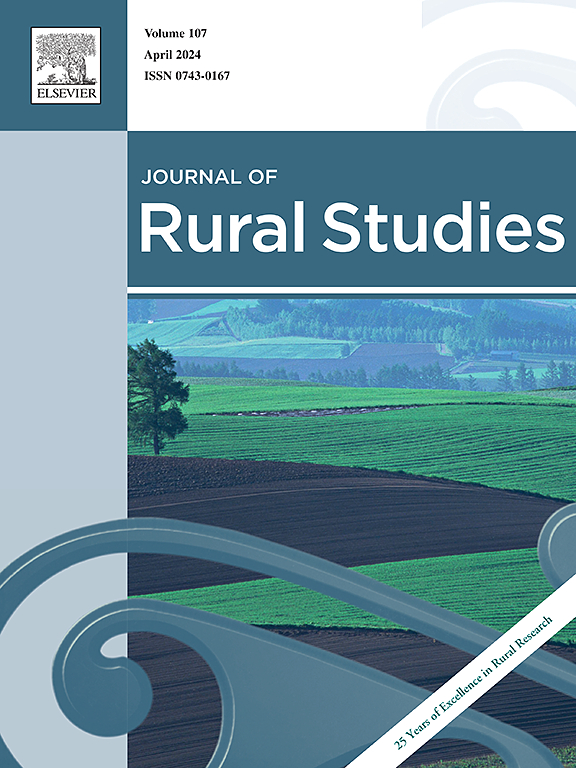中国示范村镇时空格局、区域差异及形成机制
IF 5.1
1区 社会学
Q1 GEOGRAPHY
引用次数: 0
摘要
在全球乡村衰落的背景下,以产业发展带动乡村经济振兴是乡村振兴的首要路径。本文对2011 - 2021年中国“一村一品”示范乡镇的时空演变进行了刻画,利用热点分析探索了其空间聚类特征,利用达格姆基尼系数研究了其空间差异,利用地理探测器识别了影响因素,并分析了其影响机制,揭示了其中隐藏的问题。结果表明:广东省dvt数量呈上升趋势,但主导行业类别差异显著,以农业dvt为主;水果种植、蔬菜、食用菌和园艺以及作物种植占主导地位。dvt呈现东密西疏、北密南疏的空间格局,发展趋势较为均衡。dvt的空间聚集减弱,局部聚集增强,主要集中在亚冷区和冷点区。dvt具有空间非均衡性,呈逐渐增大的趋势,空间变异的主要来源是区域间的交叉影响。在地理条件、资源条件等基础条件的基础上,市场需求导向和政策引导是交通水平和经济基础支撑的结果。区域不平衡、产业同质化风险、传统农业局限性等问题是深空产业空间格局背后亟待解决的问题。其实质是支持区域内经济增长核心的发展,形成专业化的生产集群,实现县、镇、村的产业联动,构建城乡一体化的产业体系。中国dvt自上而下和自下而上的复合发展模式对其他发展中国家具有借鉴意义。我们根据具体结果和发现的潜在问题,提出了促进dvt发展的措施,为全球农村经济增长提供参考。本文章由计算机程序翻译,如有差异,请以英文原文为准。
Spatiotemporal patterns, regional differences, and formation mechanisms of demonstration villages and towns in China
Promoting rural economic revitalization through industrial development is the primary path towards rural revitalization amid global rural decline. We portrayed the spatiotemporal evolution of “One Village, One Product” demonstration villages and towns (DVTs) in China from 2011 to 2021, explored their spatial clustering characteristics using hotspot analysis, investigated spatial differences using Dagum Gini Coefficient, identified influencing factors using geo-detector, and analyzed their influencing mechanisms to reveal the hidden issues. Results indicated that the number of DVTs increased, but the dominant industry categories differed significantly, with agricultural DVTs dominating. Fruit cultivation, vegetables, edible fungi and horticulture, and crop cultivation dominated industrial subcategories. DVTs presented a spatial pattern of dense east and sparse west, dense north and sparse south, with a balanced development trend. Spatial aggregation of DVTs was weakened but locally enhanced, mainly in sub-cold and cold spot areas. DVTs were characterized by spatial non-equilibrium, which gradually increased, and the primary sources of spatial variation were cross-influences between different regions. The spatial pattern evolution of DVTs results from the market demand orientation and policy guidance, supported by traffic level and economic foundation, on top of the basic conditions of DVTs such as geographical conditions and resources. Issues like regional imbalance, industrial homogenization risk, and traditional agricultural limitations are evident behind the spatial pattern of DVTs, which urgently need to be addressed. The essence of the DVTs is to support the development of economic growth cores within them, form specialized production clusters, realize industrial linkages between counties, towns and villages, and build integrated urban-rural industrial systems. The composite top-down and bottom-up development model of China's DVTs is transferable to other developing countries. We proposed measures to foster DVTs based on specific results and the potential problems revealed, offering insights for global rural economic growth.
求助全文
通过发布文献求助,成功后即可免费获取论文全文。
去求助
来源期刊

Journal of Rural Studies
Multiple-
CiteScore
9.80
自引率
9.80%
发文量
286
期刊介绍:
The Journal of Rural Studies publishes research articles relating to such rural issues as society, demography, housing, employment, transport, services, land-use, recreation, agriculture and conservation. The focus is on those areas encompassing extensive land-use, with small-scale and diffuse settlement patterns and communities linked into the surrounding landscape and milieux. Particular emphasis will be given to aspects of planning policy and management. The journal is international and interdisciplinary in scope and content.
 求助内容:
求助内容: 应助结果提醒方式:
应助结果提醒方式:


